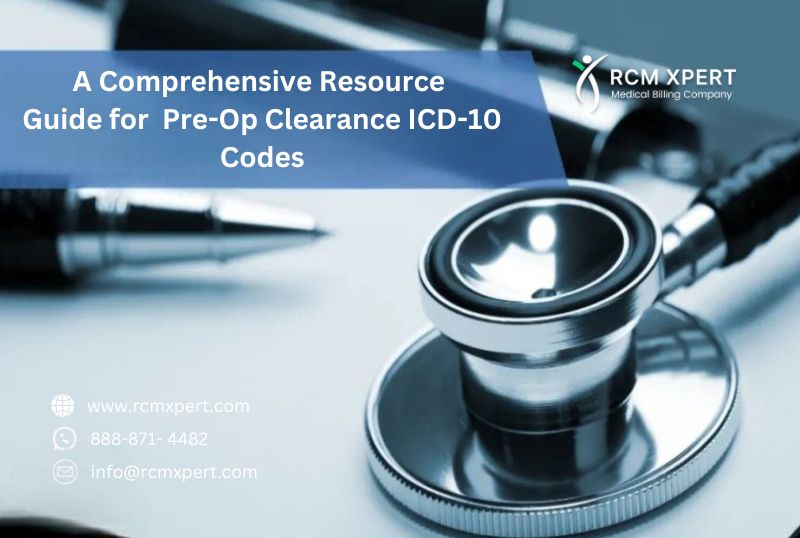What are pre-op clearance ICD-10 codes?
Pre-op clearance ICD-10 codes are specialized medical codes used to document the process of evaluating a patient’s fitness for surgery. These codes are part of the International Classification of Diseases, 10th Revision (ICD-10) system, which is used worldwide to classify and code all diagnoses, symptoms, and procedures.
When a patient is scheduled for surgery, they often need to undergo a pre-operative evaluation to ensure they’re healthy enough for the procedure. This evaluation, known as pre-op clearance, involves a thorough assessment of the patient’s overall health, including any existing medical conditions, medications, and potential risk factors.
The pre-op clearance ICD-10 codes help healthcare providers accurately record this evaluation process, ensuring proper documentation and communication among medical professionals involved in the patient’s care.
Why are pre-op clearance ICD-10 codes important?
Pre-op clearance ICD-10 codes play a crucial role in the healthcare system for several reasons:
1. Accurate documentation: These codes provide a standardized way to record the pre-operative evaluation process, ensuring that all relevant information is captured and easily accessible to healthcare providers.
2. Communication: The codes facilitate clear communication between different healthcare professionals involved in a patient’s care, from primary care physicians to surgeons and anesthesiologists.
3. Risk assessment: By using specific codes to document pre-existing conditions and potential risk factors, healthcare providers can better assess and mitigate surgical risks.
4. Insurance and billing: Accurate coding is essential for proper insurance claims processing and billing, ensuring that healthcare providers are reimbursed correctly for their services.
5. Quality improvement: The use of standardized codes allows for better data analysis, which can lead to improvements in patient care and surgical outcomes.
Common pre-op clearance ICD-10 codes
Let’s explore some of the most frequently used pre-op clearance ICD-10 codes:
Z01.810 – Encounter for preprocedural cardiovascular examination
This code is used when a patient undergoes a cardiovascular evaluation before surgery. It’s particularly important for patients with a history of heart problems or those undergoing procedures that may put stress on the cardiovascular system.
Z01.811 – Encounter for preprocedural respiratory examination
Used when a patient receives a respiratory evaluation before surgery, this code is crucial for patients with lung conditions or those undergoing procedures that may affect breathing.
Z01.812 – Encounter for preprocedural laboratory examination
This code indicates that preoperative laboratory tests were performed, such as blood work or urinalysis, to assess the patient’s overall health and identify any potential issues.
Z01.818 – Encounter for other preprocedural examination
When a patient undergoes a pre-operative evaluation that doesn’t fit into the more specific categories, this code is used. It could include general physical examinations or assessments of other body systems.
Z01.89 – Encounter for other specified special examinations
This code is used for other types of pre-operative evaluations that are not covered by the more specific codes mentioned above.
How to use pre-op clearance ICD-10 codes effectively
To make the most of pre-op clearance ICD-10 codes, healthcare providers should follow these best practices:
1. Be specific: Choose the most precise code that accurately describes the pre-operative evaluation being performed.
2. Use multiple codes when necessary: If a patient undergoes multiple types of pre-op evaluations, use all relevant codes to provide a complete picture of the clearance process.
3. Include additional diagnosis codes: When applicable, include codes for any underlying conditions or risk factors identified during the pre-op evaluation.
4. Stay up-to-date: ICD-10 codes are periodically updated, so make sure to use the most current version of the code set.
5. Document thoroughly: Provide detailed notes to support the use of each code, ensuring that the medical record accurately reflects the pre-op clearance process.
Common challenges in using pre-op clearance ICD-10 codes
While pre-op clearance ICD-10 codes are invaluable tools for healthcare documentation, they can present some challenges:
1. Code specificity: Choosing the most appropriate code can be difficult, especially when dealing with complex cases or multiple evaluations.
2. Changing guidelines: As medical knowledge evolves, coding guidelines may change, requiring healthcare providers to stay informed and adapt their coding practices.
3. Coordination between specialties: Ensuring proper communication and code usage across different medical specialties involved in a patient’s care can be challenging.
4. Documentation requirements: Adequate documentation is crucial to support the use of specific codes, which can be time-consuming for healthcare providers.
5. Insurance and reimbursement issues: Incorrect coding can lead to denied claims or delayed reimbursements, causing financial and administrative headaches for healthcare providers.
Tips for improving pre-op clearance coding accuracy
To enhance the accuracy of pre-op clearance coding, consider the following tips:
1. Provide ongoing education: Offer regular training sessions for healthcare providers and coding staff to keep them updated on the latest ICD-10 guidelines and best practices.
2. Implement coding software: Utilize coding assistance software that can help suggest appropriate codes based on documented diagnoses and procedures.
3. Conduct regular audits: Perform routine audits of coded records to identify areas for improvement and ensure compliance with coding guidelines.
4. Foster communication: Encourage open communication between healthcare providers and coding specialists to clarify any questions or concerns about pre-op evaluations and appropriate code selection.
5. Create coding cheat sheets: Develop quick reference guides for commonly used pre-op clearance codes to help streamline the coding process.
The future of pre-op clearance ICD-10 codes
As healthcare continues to evolve, we can expect to see changes in how pre-op clearance is documented and coded. Some potential developments include:
1. Greater specificity: Future updates to the ICD-10 system may introduce more specific codes for pre-op clearance, allowing for even more detailed documentation of the evaluation process.
2. Integration with electronic health records (EHRs): Improved integration between coding systems and EHRs may streamline the pre-op clearance documentation process, reducing the burden on healthcare providers.
3. Artificial intelligence (AI) assistance: AI-powered tools may help suggest appropriate codes based on clinical documentation, improving coding accuracy and efficiency.
4. Focus on outcomes: Future coding systems may place greater emphasis on linking pre-op clearance codes with post-operative outcomes, facilitating better quality improvement efforts.
5. Telehealth considerations: As telehealth becomes more prevalent, new codes may be introduced to reflect pre-op clearance evaluations conducted remotely.
Conclusion
Pre-op clearance ICD-10 codes are essential tools for documenting and communicating critical information about a patient’s fitness for surgery. By understanding these codes and using them effectively, healthcare providers can improve patient care, streamline communication, and ensure accurate billing and reimbursement.
As the healthcare landscape continues to evolve, staying informed about updates to pre-op clearance coding guidelines and best practices will be crucial for healthcare providers, coders, and administrators alike. By embracing ongoing education, leveraging technology, and fostering clear communication, the healthcare community can maximize the benefits of pre-op clearance ICD-10 codes and ultimately improve surgical outcomes for patients.














